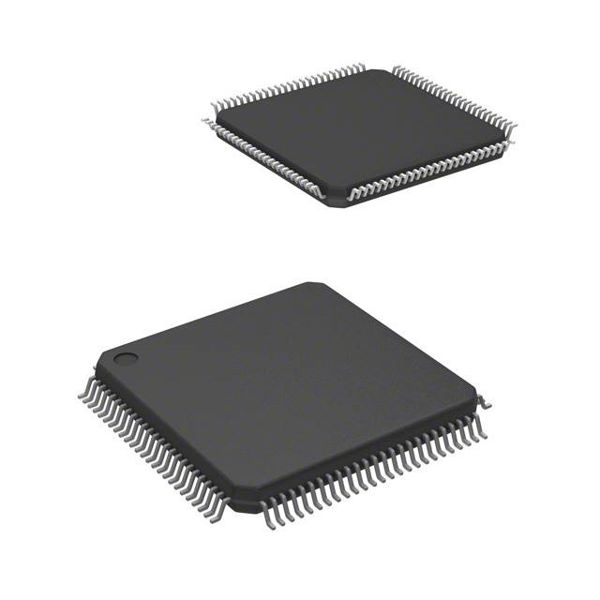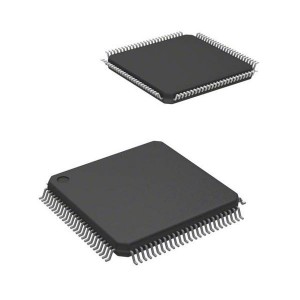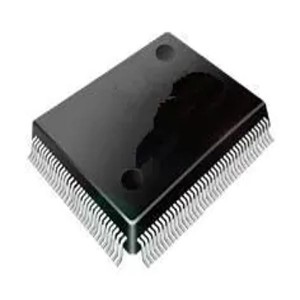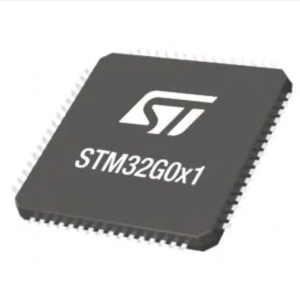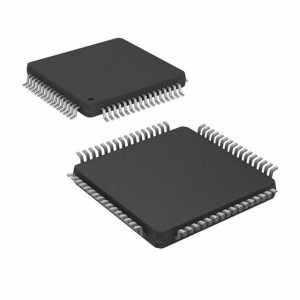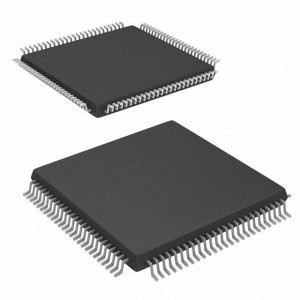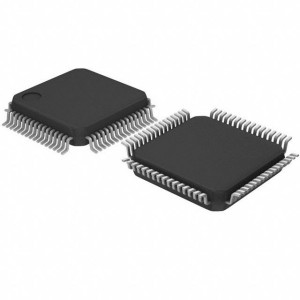AT91SAM7X256C-AU Microcontroladores ARM – MCU LQFP GRN IND TMP MRL C
♠ Product Description
| Atributo del producto | Valor de atributo |
| Fabricante: | Microchip |
| Categoría de producto: | Microcontroladores ARM - MCU |
| RoHS: | Detalles |
| Serie: | SAM7X/XC |
| Estilo de montaje: | SMD/SMT |
| Paquete / Cubierta: | LQFP-100 |
| Núcleo: | ARM7TDMI |
| Tamaño de memoria del programa: | 256 kB |
| Ancho de bus de datos: | 32 bit |
| Resolución del conversor de señal analógica a digital (ADC): | 10 bit |
| Frecuencia de reloj máxima: | 20 MHz |
| Número de entradas / salidas: | 62 I/O |
| Tamaño de RAM de datos: | 64 kB |
| Voltaje de alimentación - Mín.: | 1.65 V |
| Voltaje de alimentación - Máx.: | 1.95 V |
| Temperatura de trabajo mínima: | - 40 C |
| Temperatura de trabajo máxima: | + 85 C |
| Empaquetado: | Tray |
| Voltaje de suministro analógico: | 3.3 V |
| Marca: | Microchip Technology / Atmel |
| Voltaje de entrada / salida: | 3.3 V |
| Tipo de interfaz: | SPI |
| Sensibles a la humedad: | Yes |
| Cantidad de temporizadores/contadores: | 1 Timer |
| Serie de procesadores: | SAM7X256 |
| Tipo de producto: | ARM Microcontrollers - MCU |
| Tipo de memoria de programa: | Flash |
| Cantidad de empaque de fábrica: | 90 |
| Subcategoría: | Microcontrollers - MCU |
| Peso de la unidad: | 0.046530 oz |
♠ SAM7X512 / SAM7X256 / SAM7X128
The Atmel SAM7X512/256/128 is a highly-integrated Flash microcontroller based on the 32-bit ARM® RISC processor. It features 512/256/128 Kbytes of high-speed Flash and 128/64/32 Kbytes of SRAM, a large set of peripherals, including an 802.3 Ethernet MAC, and a CAN controller. A complete set of system functions minimizes the number of external components.
The embedded Flash memory can be programmed in-system via the JTAG-ICE interface or via a parallel interface on a production programmer prior to mounting. Builtin lock bits and a security bit protect the firmware from accidental overwrite and preserve its confidentiality
The SAM7X512/256/128 system controller includes a reset controller capable of managing the power-on sequence of the microcontroller and the complete system. Correct device operation can be monitored by a built-in brownout detector and a watchdog running off an integrated RC oscillator.
By combining the ARM7TDMI® processor with on-chip Flash and SRAM, and a wide range of peripheral functions, including USART, SPI, CAN controller, Ethernet MAC, Timer Counter, RTT and analog-to-digital converters on a monolithic chip, the SAM7X512/256/128 is a powerful device that provides a flexible, cost-effective solution to many embedded control applications requiring communication over Ethernet, wired CAN and ZigBee® wireless networks.
Incorporates the ARM7TDMI ARM Thumb® Processor
High-performance 32-bit RISC Architecture
High-density 16-bit Instruction Set
Leader in MIPS/Watt
EmbeddedICE™ In-circuit Emulation, Debug Communication Channel Support
Internal High-speed Flash
512 Kbytes (SAM7X512) Organized in Two Banks of 1024 Pages of 256 Bytes (Dual Plane)
256 Kbytes (SAM7X256) Organized in 1024 Pages of 256 Bytes (Single Plane)
128 Kbytes (SAM7X128) Organized in 512 Pages of 256 Bytes (Single Plane)
Single Cycle Access at Up to 30 MHz in Worst Case Conditions
Prefetch Buffer Optimizing Thumb Instruction Execution at Maximum Speed
Page Programming Time: 6 ms, Including Page Auto-erase, Full Erase Time: 15 ms
10,000 Write Cycles, 10-year Data Retention Capability, Sector Lock Capabilities, Flash Security Bit
Fast Flash Programming Interface for High Volume Production
Internal High-speed SRAM, Single-cycle Access at Maximum Speed
128 Kbytes (SAM7X512)
64 Kbytes (SAM7X256)
32 Kbytes (SAM7X128)
Memory Controller (MC)
Embedded Flash Controller, Abort Status and Misalignment Detection
Reset Controller (RSTC)
Based on Power-on Reset Cells and Low-power Factory-calibrated Brownout Detector
Provides External Reset Signal Shaping and Reset Source Status
Clock Generator (CKGR)
Low-power RC Oscillator, 3 to 20 MHz On-chip Oscillator and one PLL
Power Management Controller (PMC)
Power Optimization Capabilities, Including Slow Clock Mode (Down to 500 Hz) and Idle Mode
Four Programmable External Clock Signals
Advanced Interrupt Controller (AIC)
Individually Maskable, Eight-level Priority, Vectored Interrupt Sources
Two External Interrupt Sources and One Fast Interrupt Source, Spurious Interrupt Protected
Debug Unit (DBGU)
2-wire UART and Support for Debug Communication Channel interrupt, Programmable ICE Access Prevention
Mode for General Purpose 2-wire UART Serial Communication
Periodic Interval Timer (PIT)
20-bit Programmable Counter plus 12-bit Interval Counter
Windowed Watchdog (WDT)
12-bit key-protected Programmable Counter
Provides Reset or Interrupt Signals to the System
Counter May Be Stopped While the Processor is in Debug State or in Idle Mode
Real-time Timer (RTT)
32-bit Free-running Counter with Alarm
Runs Off the Internal RC Oscillator
Two Parallel Input/Output Controllers (PIO)
Sixty-two Programmable I/O Lines Multiplexed with up to Two Peripheral I/Os
Input Change Interrupt Capability on Each I/O Line
Individually Programmable Open-drain, Pull-up Resistor and Synchronous Output
Thirteen Peripheral DMA Controller (PDC) Channels
One USB 2.0 Full Speed (12 Mbits per second) Device Port
On-chip Transceiver, 1352-byte Configurable Integrated FIFOs
One Ethernet MAC 10/100 base-T
Media Independent Interface (MII) or Reduced Media Independent Interface (RMII)
Integrated 28-byte FIFOs and Dedicated DMA Channels for Transmit and Receive
One Part 2.0A and Part 2.0B Compliant CAN Controller
Eight Fully-programmable Message Object Mailboxes, 16-bit Time Stamp Counter
One Synchronous Serial Controller (SSC)
Independent Clock and Frame Sync Signals for Each Receiver and Transmitter
I²S Analog Interface Support, Time Division Multiplex Support
High-speed Continuous Data Stream Capabilities with 32-bit Data Transfer
Two Universal Synchronous/Asynchronous Receiver Transmitters (USART)
Individual Baud Rate Generator, IrDA® Infrared Modulation/Demodulation
Support for ISO7816 T0/T1 Smart Card, Hardware Handshaking, RS485 Support
Full Modem Line Support on USART1
Two Master/Slave Serial Peripheral Interfaces (SPI)
8- to 16-bit Programmable Data Length, Four External Peripheral Chip Selects
One Three-channel 16-bit Timer/Counter (TC)
Three External Clock Inputs, Two Multi-purpose I/O Pins per Channel
Double PWM Generation, Capture/Waveform Mode, Up/Down Capability
One Four-channel 16-bit Power Width Modulation Controller (PWMC)
One Two-wire Interface (TWI)
Master Mode Support Only, All Two-wire Atmel EEPROMs and I2 C Compatible Devices Supported
One 8-channel 10-bit Analog-to-Digital Converter, Four Channels Multiplexed with Digital I/Os
SAM-BA® Boot Assistance
Default Boot program
Interface with SAM-BA Graphic User Interface
IEEE® 1149.1 JTAG Boundary Scan on All Digital Pins
5V-tolerant I/Os, Including Four High-current Drive I/O lines, Up to 16 mA Each
Power Supplies Embedded 1.8V Regulator, Drawing up to 100 mA for the Core and External Components
3.3V VDDIO I/O Lines Power Supply, Independent 3.3V VDDFLASH Flash Power Supply
1.8V VDDCORE Core Power Supply with Brownout Detector
Fully Static Operation: Up to 55 MHz at 1.65V and 85°C Worst Case Conditions
Available in 100-lead LQFP Green and 100-ball TFBGA Green Packages
